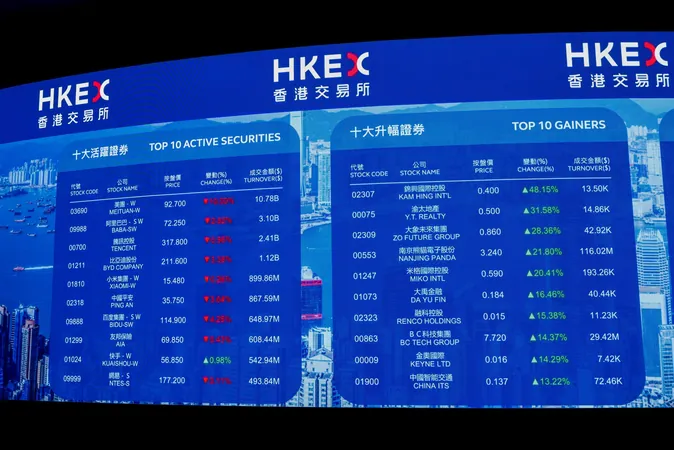
Hong Kong Turns the Tables: China's Major Shift from Wall Street to Local Markets
2025-06-02
Author: Yan
A Bold Move in Troubling Times
In the midst of a jittery global market reacting to President Trump's erratic tariff policies, a significant shift is unfolding in US-China economic relations—especially in the bustling Hong Kong stock market. Amidst this backdrop, a Chinese tech giant has turned its back on Wall Street, unveiling the largest share offering of 2025.
CATL's Bold IPO: A Defiance Against US Policies
Contemporary Amperex Technology Co. (CATL), a leading battery manufacturer, has made headlines with its groundbreaking $4.6 billion initial public offering (IPO) in May. This move is not just a financial maneuver; it's a bold response to the US Department of Defense's decision to place the company on a watchlist due to alleged military ties. This reflects the growing fragility of US-China business relations.
China Reshapes Its Business Landscape
China is systematically steering its companies away from New York. For instance, Chery Automobile, the country's second-largest car maker, is gearing up for a $1.5 billion IPO in Hong Kong. In recent years, roughly 75% of the top 25 Chinese firms listed on US exchanges have established parallel listings in Hong Kong, symbolizing a strategic escape route amid the looming threat of delistings by the US.
Investors Take Notice: A Shift in Strategy
American investors can still buy Chinese stocks through accounts in Hong Kong, prompting some fund managers to pivot their holdings to these dual-listed shares to safeguard against possible disruptions. However, many institutional investors remain sidelined due to governance rules, unable to participate in CATL’s IPO, which was specifically structured to avoid US regulatory scrutiny.
Beijing's Vision for Hong Kong
Hong Kong’s rise as a preferred market for Chinese enterprises is no coincidence; the Chinese government has been diligently reviving its status as a financial center, particularly after a significant foreign investor exodus following political unrest in 2019. The goal? Establish Hong Kong as the premier venue for offshore transactions in renminbi, with the stock market increasingly central to this strategy.
The Dance of National Security and Financial Independence
US and Chinese officials are locked in a complex dance over national security concerns regarding Chinese corporations on American soil. Multiple administrations have sought to exclude companies deemed part of China's military-industrial complex from US markets, leading to harsh repercussions such as delistings.
The Financial Rollercoaster of Chinese Listings
While the political landscape has shifted dramatically, so too has the financial. Chinese IPOs in the US have plummeted since 2021, marked by a series of regulatory crackdowns. In 2024, US venture capital investments in China drastically declined compared to earlier years, underscoring the tightening grip of nationalism on both sides.
Hong Kong's IPO Surge: A New Dawn?
Prior to CATL, Hong Kong was already experiencing a surge in IPO activities. The first quarter of the year saw a 25% increase in listings, with total value skyrocketing to $2.3 billion—a staggering 287% jump. The majority of these listings are from Chinese companies, indicating a shift in capital flows.
The Pros and Cons of Listing in Hong Kong
Despite the advantages, Hong Kong listings come with their own challenges—greater market volatility and lower trading volumes compared to the US. However, Hong Kong provides access to an underutilized pool of Chinese investors, with significant growth in their participation over the past few years.
The Bigger Picture: A Calculated Trade-off
Though the allure of China’s retail investors offers some comfort, it's ultimately the Chinese government that stands to gain the most. The ongoing 'decoupling‘ from Wall Street reflects a strategic decision: the political benefits of a compliant international financial hub like Hong Kong outweigh the economic pains of distancing from US markets.




 Brasil (PT)
Brasil (PT)
 Canada (EN)
Canada (EN)
 Chile (ES)
Chile (ES)
 Česko (CS)
Česko (CS)
 대한민국 (KO)
대한민국 (KO)
 España (ES)
España (ES)
 France (FR)
France (FR)
 Hong Kong (EN)
Hong Kong (EN)
 Italia (IT)
Italia (IT)
 日本 (JA)
日本 (JA)
 Magyarország (HU)
Magyarország (HU)
 Norge (NO)
Norge (NO)
 Polska (PL)
Polska (PL)
 Schweiz (DE)
Schweiz (DE)
 Singapore (EN)
Singapore (EN)
 Sverige (SV)
Sverige (SV)
 Suomi (FI)
Suomi (FI)
 Türkiye (TR)
Türkiye (TR)
 الإمارات العربية المتحدة (AR)
الإمارات العربية المتحدة (AR)